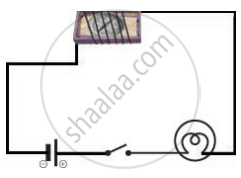Advertisements
Advertisements
प्रश्न
A charged body ______ an uncharged body towards it.
उत्तर
A charged body attracts an uncharged body towards it.
Explanation:
This attraction results from the induction effect. When a charged body comes into contact with an uncharged body, the charges in the latter redistribute themselves. The opposite charges are attracted to the charged body, resulting in a net attractive force between them.
APPEARS IN
संबंधित प्रश्न
Make a match
| A group | B group |
| 1. Fluid | a. Higher pressure |
| 2. Blunt knife | b. Atmospheric pressure |
| 3. sharp needle | c. Specific gravity |
| 4. Relative density | d. Lower pressure |
| 5. Hecto pascal | e. Same pressure in all directions |
State the effects of a force applied on
- A non-rigid, and
- A rigid body.
How does the effect of the force differ in the two cases?
Give one example in each of the following cases where a force:
(i) Stops a moving body.
(ii) Moves a stationary body.
(iii) Changes the size of a body.
(iv) Changes the shape of a body.
A car of mass 1000 kg develops a force of 500 N over a distance of 49 m. If initially, the car is at rest find
- Final velocity
- time for which it accelerates.
State four effects which a force can bring about. Give two examples in each case.
Explain the following:
Why is it dangerous to jump out of a moving vehicle? How can the danger be minimised?
Multiple Choice Question. Select the correct option.
A man is walking from east to west on a rough surface. The force on the man is directed:
The force which acts on an object without physical contact. ______
In the circuit shown in figure, when the key is closed, the compass needle placed in the match box deflects. Name the force which cases this deflection.

 Figure shows a car sticking to an electromagnet. Name the forces acting on the car. Which one of them is larger?
Figure shows a car sticking to an electromagnet. Name the forces acting on the car. Which one of them is larger?
